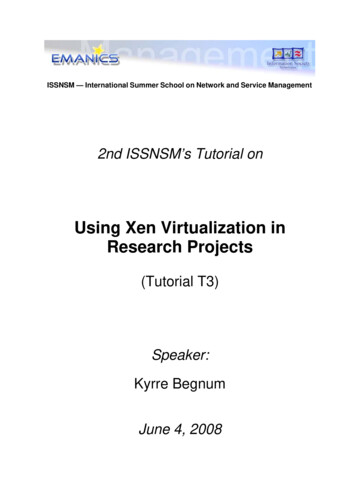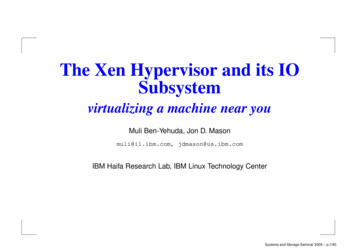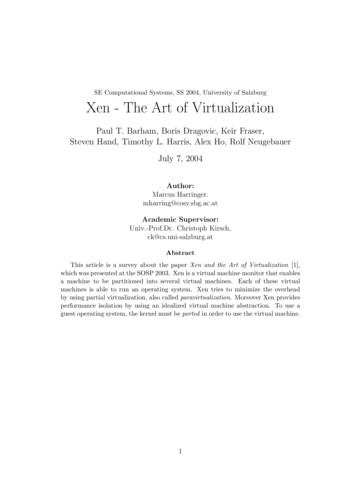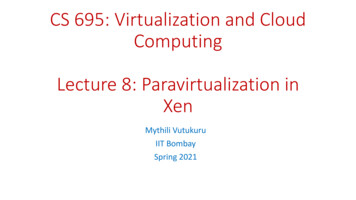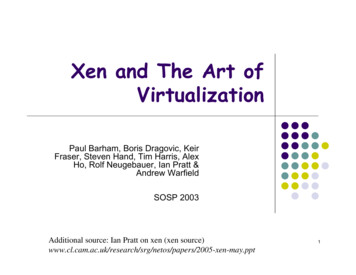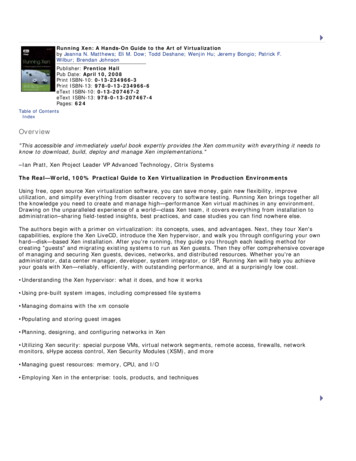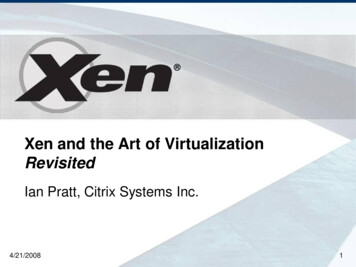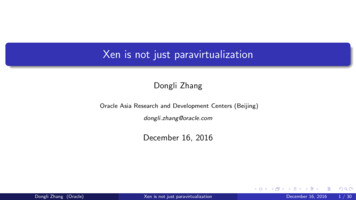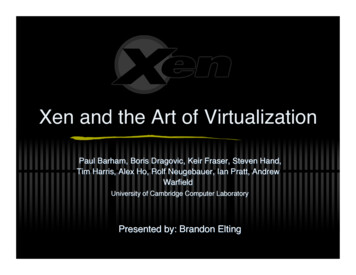
Transcription
Xen and the Art of VirtualizationPaul Barham, Boris Dragovic, Keir Fraser, Steven Hand,Tim Harris, Alex Ho, Rolf Neugebauer, Ian Pratt, AndrewWarfieldUniversity of Cambridge Computer LaboratoryPresented by: Brandon Elting
Outline Why Virtualization? Overview of Xen Benchmark Results Xen Today Conclusion
Outline Why Virtualization? Overview of Xen Benchmark Results Xen Today Conclusion
Why Virtualization? Problem Domain Virtualization Paravirtualization
Problem Domain Need to execute a diverse range of applications andservices Need to support multiple OSes and configurations Solution: Run multiple processes on a single machine Unfortunate configuration interactions Solution: Run separate OSes on different machines Maintenance Issues Keep machines busy Support Legacy Software on Modern Hardware
Virtualization Present the illusion of many small Virtual Machines to runmultiple instances of different Operating Systems concurrently Virtual Machine exactly like physical machine Pros Can run unmodified OSes in VM Cons PerformanceUncooperative hardware Solution: binary rewriting Examples VM/370, VMware, Disco
Paravirtualization Present an idealized VM abstraction to guest OSes Differs from underlying hardware interface Pros Can deal with difficult to virtualize architectures Exposing both a virtual and real interface leads topotential performance enhancements Cons Must port existing OSes to run on paravirtualized host Example Denali
Outline Why Virtualization? Overview of Xen Benchmark Results Xen Today Conclusion
Overview of Xen High-Performance, Paravirtualized Virtual MachineMonitor/Hypervisor Runs on 32-bit x86 Processors Provides an environment to execute up to 100 VM instancessimultaneously Focus on Performance Isolation Attempts to minimize overhead associated with virtualization Supports Ported Guest Operating Systems XenoLinux - Port of Linux 2.4XenoXP - Port of Windows XP (in development)
Machine Running Xen inux)(XenoLinux)(XenoBSD)(XenoXP)Xeno-AwareDevice DriversXeno-AwareDevice DriversXeno-AwareDevice DriversXeno-AwareDevice DriversDomain0ControlInterfaceVirtualx86 DevH/W (SMP x86, physical memory, enet, SCSI/IDE)
Virtual Machine Interface CPU Memory Device I/O Control Management
Virtualized CPU CPU Execution Privilege Levels x86 has four privileged levels (rings) 0-3 (0 more 3 less)Xen runs at ring0, Guest OS at ring1, apps at ring3Exception Handling Non-Privileged Instructions can run directly on “bare hardware”Privileged operations must be marshaled by XenGuest provides virtual IDTMost ISRs same as on real x86 hardware, page-fault is special caseInterrupts and Events Handled via “event channels,” Xen upcalls into guestMaskable, analogous to disabling interrupts‘Fast’ exception handler for Guest OS system-calls
Memory Management 1 Page Tables Translation Lookaside Buffer Guests responsible for managing their own page tablesUpdates to page tables must go through XenGuests have direct read access to page tablesUpdates to page tables can be batchedPage frames contain reference count and typex86’s hardware managed TLB complicates virtualizationXen mapped to the top 64MB of each address space, saves TLB flushesSegmentation Handled in a similar manner as page tables
Memory Management 2 Physical Memory Most Operating Systems expect contiguous memory addressesIllusion of contiguous physical memory provided by physicalhardware mapExposing both hardware and physical memory addressesprovides area for optimization Cache locality
Device I/O Xen exposes a set of clean and simple device abstractionsI/O data transferred between guest and Xen via aync I/O RingsNetwork Device VFR - Virtual Firewall-RouterVIF - Virtual Network InterfaceDisks VBD - Virtual Block Devices
Control Management Domain0 Created at Xen boot-time Has access to Xen’s control interface Hosts application-level managementsoftware Provides separation of policy andmechanism
Control Transfer Hypercalls Synchronous communication between Hypervisorand Guest Analogous to system calls Events Asynchronous notifications to domains Used to notify domains of device driver interrupts Lightweight notification of important events ie. Domain-termination requests
Data Transfer I/O Rings Mechanism to allow efficient moving of datavertically through system Based around two pairs of producer-consumerpointers Unique request ids allow reordering Allows producer to enqueue multiple requests anddefer notifying consumer
Outline Why Virtualization? Overview of Xen Benchmark Results Xen Today Conclusion
Benchmark Results Compare Linux to different Virtualization tecnhiques XenoLinux compared against Linux, VMWare, User-Mode Linux Benchmarks SPEC: cpu intensiveLinux build: 7% of time spent in kernelOSDB-IR/OLTP: OS intensive, many domain transitionsDbench: filesystem intensiveSPEC WEB99: good overall measure
USPEC INT2000 (score)LXVULinux build time (s)LXVUOSDB-OLTP (tup/s(tup/s))LXVUSPEC WEB99 (score)Benchmark suite running on Linux (L), Xen (X), VMware Workstation (V), and UML (U)Source: xen-lwe2005-short.ppt
Concurrent VM10008006004002000LX2LX4LX8LX16Simultaneous SPEC WEB99 Instances on Linux (L) and Xen(X)Source: xen-lwe2005-short.ppt
Additional Results Performance Isolation Execute domains with “anti-social” processesOSDB-IR and SPEC WEB99 only slightly affected Scalability Run up to 100 VMs concurrentlyOnly a loss of 7.5% throughput compared to Linux
Outline Why Virtualization? Overview of Xen Architecture Benchmark Results Xen Today Conclusion
Xen Today Current Version: Xen 3.2 (Released Jan ‘08) Supports HW Virtualization Extensions (Intel IVT, AMD-V) Runs unmodified OSes Supports SMP Virtualized Guest OSes Supported OSes: Windows, Linux, Solaris, BSD, Virtualizes Architectures: x86, x86/64, IA64, PowerPC, Live VM Relocation Load balancing across a clusterGraphics Virtualization: Direct3D, OpenGL
Outline Why Virtualization? Overview of Xen Benchmark Results Xen Today Conclusion
Conclusion Xen provides excellent platform fordeploying a wide variety of differingapplications Xen provides necessary protection andperformance isolation Paravirtualization provides near nativeperformance
Outline Why Virtualization? Overview of Xen Benchmark Results Xen Today Conclusion
References www.xen.org www.cl.cam.ac.uk/research/srg/netos/xen
Questions/Comments?
Xen and the Art of Virtualization Paul Barham, Boris Dragovic, Keir Fraser, Steven Hand, Tim Harris, Alex Ho, Rolf Neugebauer, Ian Pratt, Andrew . x86's hardware managed TLB complicates virtualization Xen mapped to the top 64MB of each address space, saves TLB flushes Segmentation Handled in a similar manner as page tables.


